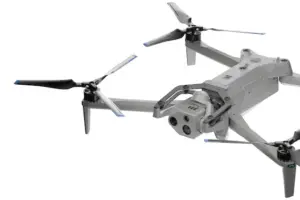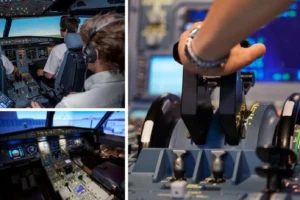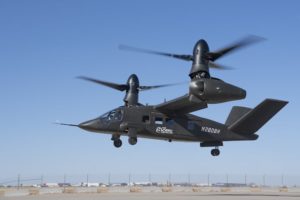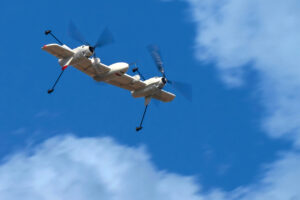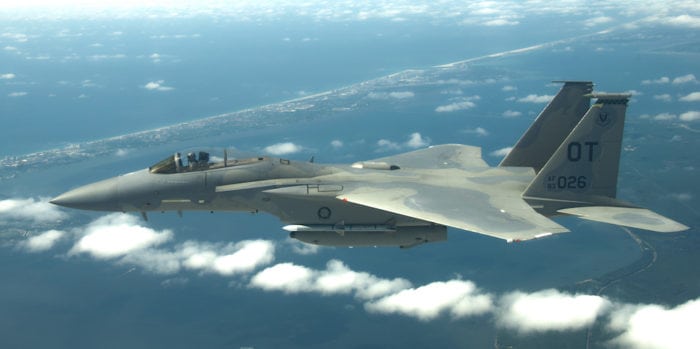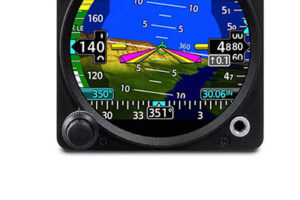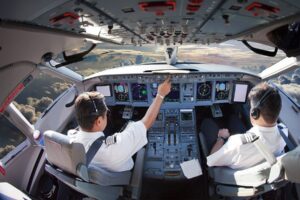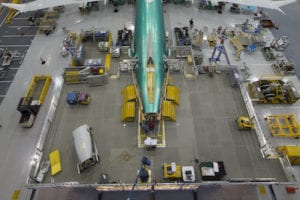From sensors to software, enhanced elements in turbine engine health monitoring and management systems (EHMS) are well worth their Krugerrand weight for providing faster, more detailed engine lifetime prediction.
In the "time is money" canon by which turbine aircraft engines are designed and operated, the ultimate equation seeks optimum on-wing time and minimum maintenance, repair and overhaul (MRO) down time. That makes the requirements for engine monitoring systems simple: first, collect data from engine operations (primarily through sensors) that can be accessed for MRO and warranty action.
Next, do so preferably well ahead of costly component failure and with the ability to distinguish false-positive or acceptable exceedances to avoid unnecessary LRU replacement or engine tear downs (through diagnostic/prognostic software tools). The system technology for achieving this performance, and indeed more sophisticated predictive capability, is anything but simple. Even the identifying language for such systems is changing.
Among alternative semantics to EHMS are: engine monitoring systems (EMS), engine performance monitoring (EPM), engine condition monitoring (ECM), health and usage monitoring system (HUMS), engine health management systems (EHMS), as specified in the revision this May of the ARP1587 specification from the international Society of Automotive Engineers’ Aerospace division, and model-based prognostics and health monitoring (PHM). For the purposes of this article, EHMS suits.
Along with shifting semantics are the increased levels of engine operating performance information desired by OEMs and their customers. In fact, contemporary EHMS architecture is about as complex as the aircraft’s full architecture, whether rotary or fixed wing, military or commercial.
The total data picture can involve elements of measuring, transmission, storage, processing, diagnostics, prognostics and systems integration. Still, this monitoring function seeks the best fix possible on when, why and where exceedance alarms or other abnormal engine operating conditions indicate a potential problem; tracks trends in engine operation in order to optimize MRO cost and support; and ultimately, will influence new engine designs based on the results of data analysis.
Just consider the multiple parameters that can be included in EHMS: pressure, temperature and speed signals, vibration accelerometer signals, electromagnetic chip detection, and acoustic signals. Actual operating conditions monitored within this short list may include rotational speeds, temperatures, pressures and vibration for blades, disks, and shafts; cold fan trim balance; actuator feedback for position deltas and rate of change; fuel and oil levels, flow rate, bleed rate, and temperature; air/fuel mix; exhaust air and outside air temperature and flow; and aircraft motion data, such as angle of attack, roll angle and acceleration in multiple axes.
"As engines get smarter, our customers — particularly on the military side — are pushing us to provide smarter EHMS products," said Scott Wright, technology leader for Unison Industries, Jacksonville, Fla. "From a sensor standpoint, that means adding more subtle and higher levels of control and indication than just positive/negative alerts to a ‘normal’ baseline." For example, rate of change outputs may be significant for electronic processing, along with the normal amplitude signals typically processed.
Unison, a GE Aviation subsidiary, supplies speed, temperature (both Resistance Temperature Detector and thermocouple), pressure and flow metering sensors. Wright added that "turbine engines continue to run hotter than ever, requiring core-mounted components capable of 350 to 450 degrees Fahrenheit operation. Also, nacelles are getting tighter due to the increased complexity of control systems. EHMS electronics, especially sensors and data acquisition units positioned within the engine, must have the robustness to handle this environment. You don’t want to get an alert for an LRU replacement, bring the aircraft in and then find out that the part is fine, but the diagnostics failed because they couldn’t take the engine heat."
Sensors provide the first element of the turbine EHMS by acquiring the physical parameter data. "High reliability is obviously paramount for these critical components," Wright said, "and has to be balanced with quick time response and accuracy."
In the data collection sequence, sensors must next have the wiring (or most recently, wireless technology, see Avionics, January 2007, p. 42, regarding Honeywell Zing system) to transmit quality signals to the data acquisition units within a turbine’s high heat and noise levels.
As such, Unison’s R&D directives involve improving low-voltage sensor signal robustness and integration with exciters, ignition leads and plugs, pressure and chip detector sensors, and wiring harnesses.
"The importance of well-constructed electrical wiring harnesses usually goes uncredited," Wright observed. "Unison does its own analysis and EMI testing to determine the correct amount of wiring shielding needed, to yield an optimal weight solution."
Such analytical and testing capability is especially important for newer engines, Wright said, "because development cycles are much shorter, with fewer iterations in which to improve materials, manufacturing processes and multilevel component functions."
Unison supplies the EHMS sensor suite on GE’s GEnx turbine engine, slated to power Boeing’s 787 Dreamliner, along with the Rolls Royce Trent 1000. The GEnx will have the highest compressor pressure ratio in aviation: 23 to 1.
Unison will also provide sensors for the U.S. Army’s T700-GE-701D engine and the GP7200 turbine for the Airbus A380. In the bizjet arena, Unison is providing electrical systems (including EHMS sensors) for GE Honda Aero Engines’ HF120 turobfan, set to power Honda Aircraft Co.’s HondaJet, and Spectrum Aeronautical’s Freedom S-40 Very Light Jets. The HF120 is rated at more than 2,000 pounds of thrust and is being designed to set new standards of fuel efficiency, durability and low noise/emissions performance for small jet engines.
"The performance requirements on the GEnx are significant, especially in the need for robust sensor signals and a high-temperature environment. We had to adapt our sensor designs to enhance data effectiveness as the processing capability of this engine kept increasing," Wright said. "This technology has flowed to the HF120."
Vibration control
Other GEnx EHMS components are being supplied by Meggitt PLC companies: vibration and rotational speed sensors from Vibro-Meter (VM), as well as bleed bias venturi air flow sensors from Whittaker Controls.
VM also provides vibration and rotational speed sensors for GE’s GE90 turbine engines, CFM International’s CFM 56, as well as vibration sensors for the GP7200 engine developed for the Airbus A380 superjumbo.
This May, Vibro-Meter UK signed an exclusive contract with Rolls Royce to integrate the complete sensors and ignition package for a new member of the BR700 engine family that should generate $30 million in revenue for VM-UK.
The package comprises a 35-part engine set with sensors for air, oil and fuel temperature, speed and pressure; shaft speed; and fuel flow and oil debris monitoring, as well as the engine’s igniter system. The Meggitt group companies as a whole provide EHMS sensor, electronics and processing components.
Wolfgang Neumann, director of aerospace at Meggitt’s Vibro-Meter subsidiary in Switzerland, said "vibration measurement is still regarded as the most important parameter for turbine engine condition monitoring."
Initially this was true primarily in terms of safety, but has evolved to include today’s digital cold trim fan balance function, which can provide significant MRO savings by conducting engine balance through in-flight data. Neumann noted VM was a partner in the development of the Integrated Mechanical Diagnostics Health and Usage Monitoring System (IMD/HUMS) for U.S. Navy and Marine Corps helicopters, which use "upwards of 25 sensor inputs from the engines, airframe, gearbox, drive train and fan rotor."
Alan Kaufman, sales and marketing director at VM-UK, said the company’s wide range of advanced sensors now provide continuous exceedance monitoring outputs, and newer engine platforms are utilizing 30 to 40 percent more sensors than the 40 to 50 contained on 1990s turbofans.
Sensor technology combined with optical pyrometers now enable direct measurement of turbine blade temperature, though this is currently focused mostly on military aircraft. VM’s microwave radar blade tip clearance control technology, achieving a 0.25 mm clearance between the case and tip of the turbine blade, can improve fuel efficiency by one percent, reduce noxious emissions by 10 percent and exhaust gas temperature by six degrees Centigrade.
Other VM sensor R&D programs are addressing the extraction of combustion process data directly from the flame using optical spectrometry.
"Meggitt’s emerging sensor technologies certainly enable tip clearance control at a time when engine OEMs have identified rotor blade measurements as critical to successful flight control performance, emissions control and hot section condition monitoring. Further, this technology provides much more information about blade state than just tip clearance.," Neumann said.
"In the space of one generation of change," Neumann added, "it has become imperative to move to condition-based maintenance using sophisticated monitoring and diagnostics."
Currently, VM is qualifying EHMS condition monitoring components for the Rolls Royce Trent 900, 1000 and GE’s GEnx power plants, including vibration sensors and selected oil temperature and quantity sensors.
Neumann said final specification of the architecture of EHMS and its integration into the measurement and communication architecture of turbine engines "is very much a detailed, interactive process between engine and airframe OEMs and EHMS suppliers, especially since each of these parties may have quite different requirements."
Cockpit interface
Unison and VM share perspectives on the amount of cockpit interface that exists relative to EHMS, or is needed.
"The importance of an EHMS cockpit interface resides in the operation of warning systems that can preempt uncontained and flight-critical engine failures. These might be caused by failures of rotating components or bearings, loss of high-energy blades, or other events that might cause a serious fire," Wright said.
From Kaufman’s perspective, "in contemporary engine platforms, much of the sensor data used by the EHMS is actually provided by the FADEC, based on inputs that are also used for engine control and limiting purposes. To that end, newer platforms are deploying more sensors, and adding to what the sensors can measure and display to the flight crew."
He added that "sharing FADEC parameters with the EHMS can provide particular benefits in condition and diagnostic functions."
Complementing sensor, wiring, and data acquisition and processing units in EHMS are the analytical software tools used to optimize MRO scheduling, engine lifetime extension, and operating and support cost reduction. Suppliers of such software (as well as other EHMS components already mentioned), often developed in partnership with engine OEMs, include Honeywell, Ametek Aerospace, Altair Avionics and Goodrich.
Most would likely agree with the conclusion of Unison’s Wright that "prognostic capability is the pot of gold at the end of the rainbow for EHMS. The future of EHMS techniques, beyond current pre-emptive features, might include engine performance anomaly detection, advanced vibration analysis, non-intrusive blade health monitoring (possibly eddy current based), on-line oil condition analysis, and electrostatic sensors to detect debris in the inlet and exhaust areas."
Wright went on to suggest that "with the advent of faster and more reliable processors and memory modules, the aircraft industry is also beginning to use model-based algorithms that can determine an aircraft’s ‘capability’ (or condition) in real time. Such model-based prognostics and health management (PHM) data could determine where a fault cause or condition is leading and in what time frame, so as to maximize engine maintainability and improve performance reliability."
VM’s Neumann agreed that the emergence of diagnostic algorithms is important and ongoing within EHMS.
"With the transition to engine care packages and power-by-the-hour, the whole commercial emphasis for the engine OEMs has shifted to a focus on minimizing maintenance costs."
Yet Neumann sees a varied approach among engine OEMs and model-based prognostic systems’ developers in terms of implementation, and expects VM to help bring clarity to those exchanges.
Whatever one’s choice for assessing turbine operating parameters, within the "time is money" equation, EHMS translates to the ultimate treasure of cutting costs and boosting safety.



